Physical Address
304 North Cardinal St.
Dorchester Center, MA 02124
Normal embryologic development of the pulmonary venous system involves creation of a connection between the left atrium and the pulmonary venous plexus, and subsequent regression of systemic-to-pulmonary venous connections. Inappropriate connection of the pulmonary venous system to the systemic venous system is termed anomalous pulmonary venous drainage .
As part of normal embryologic development, the lungs are derived from buds arising from the primitive foregut. During the initial stages of pulmonary development (25 to 27 days' gestation), the pulmonary venous drainage is through the cardinal and umbilical-vitelline venous system (systemic veins). During the later stages of development (27 to 29 days' gestation), an outpouching of the common atrium forms to the leftward of the developing septal primum. The structure, termed the common pulmonary vein, primordial pulmonary vein, or pulmonary pit, extends and bifurcates into the pulmonary venous plexus and establishes venous drainage of the developing lung buds at 28 to 30 days' gestation ( Fig. 115-1 ). Thereafter, the connection between the lung buds and the systemic venous system regresses, leaving the developing lungs with direct drainage to the left atrium.
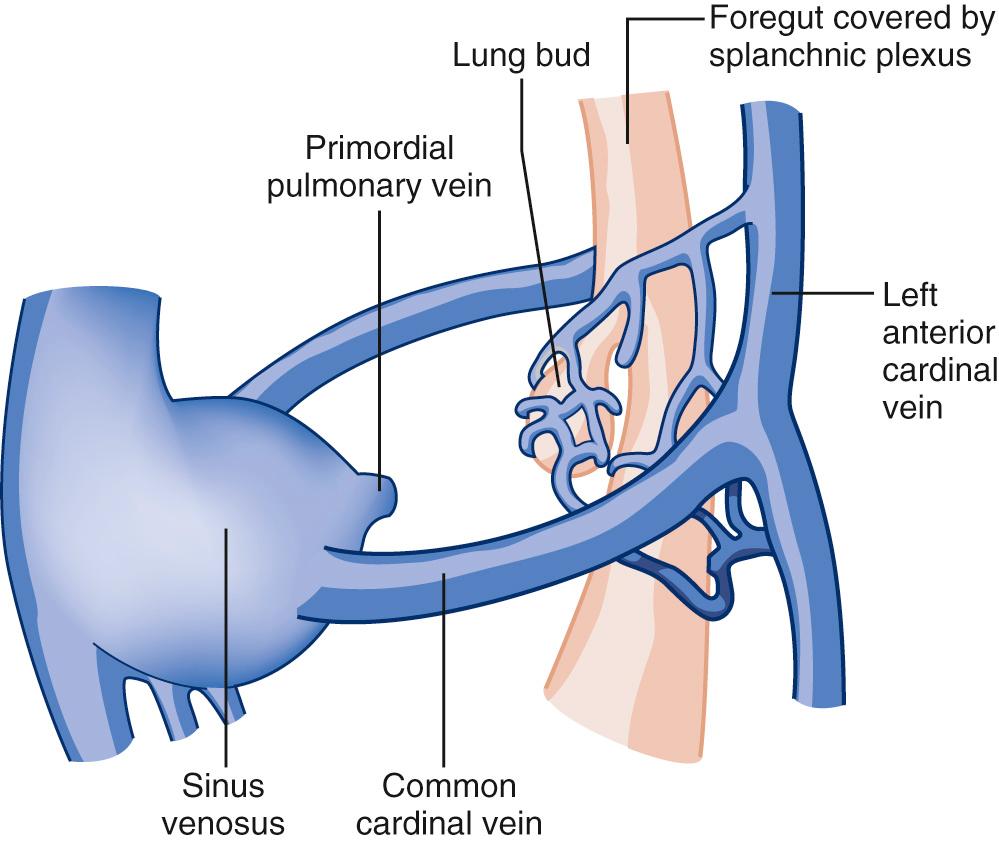
Human genetic studies of kindreds with total anomalous pulmonary venous drainage showed an autosomal-dominant inheritance with incomplete penetrance and variable expression with involvement of genetic loci located in the human chromosome 4q12. During heart morphogenesis, an avascular zone forms between the caudal primitive vascular structures (that will become part of the systemic vein circulation) and the pulmonary vein plexus, which arises from the lung. Disruption of this avascular zone and of the patterning of the pulmonary vein may be the primary developmental anomaly in the genesis of total anomalous pulmonary connection. In mice, a secreted repellent guidance molecule, semaphorin 3d, is located in the avascular zone and plays a key role in the correct patterning of the pulmonary vein connection to the left atrium ( Fig. 115-2 ). Deficiency of semaphorin 3d is associated with anomalous connection of pulmonary veins with both atria or the coronary sinus. The mechanism suggested is based on the lack of repulsion guidance that leads to a broad domain of abnormal endothelial sprouts from the lung buds which may persist when blood flow through the connection begins ( Fig. 115-3 ). In preliminary studies in humans with anomalous pulmonary venous connection, specific mutations in the gene sequence for semaphorin 3d have been identified.
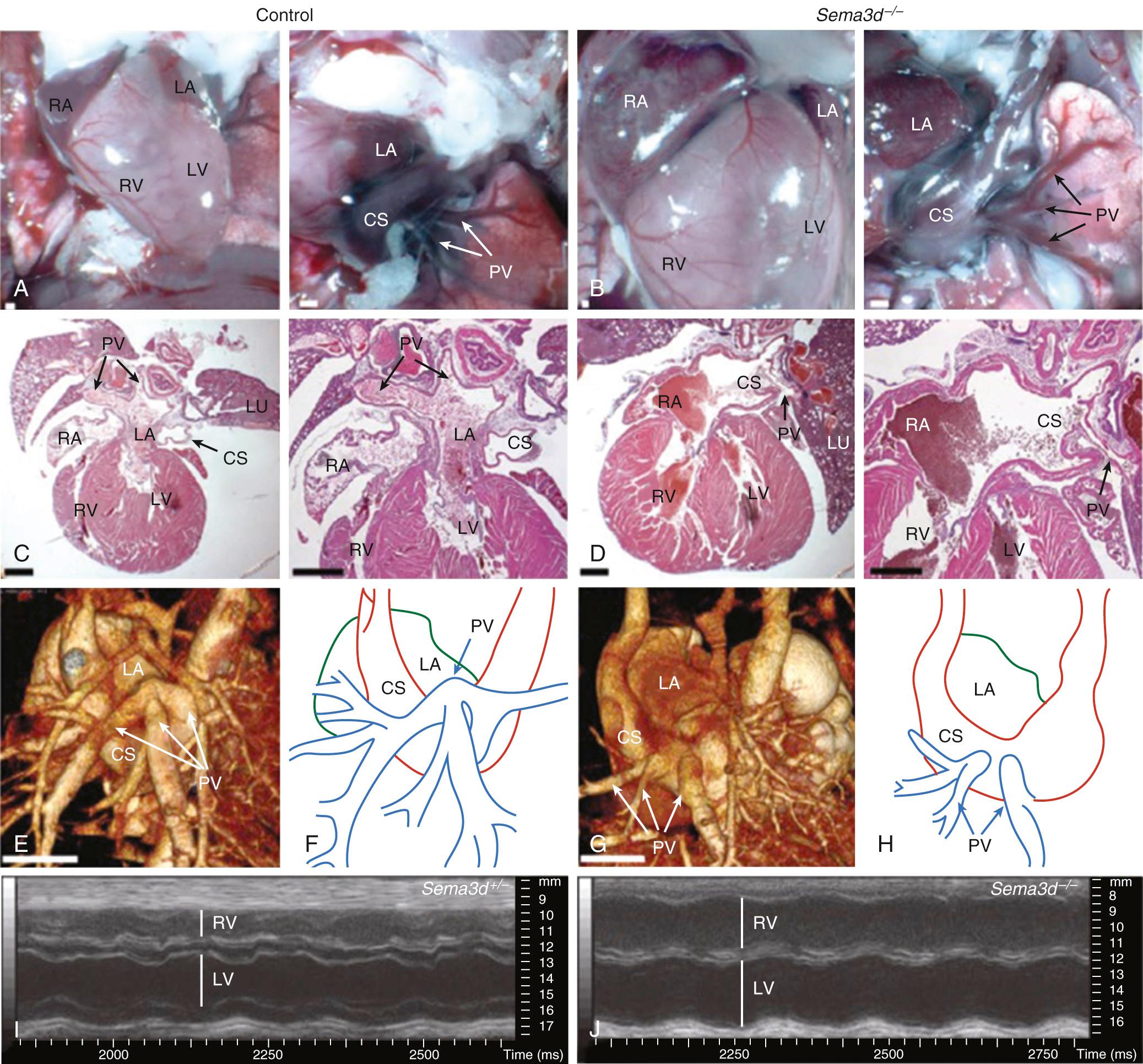
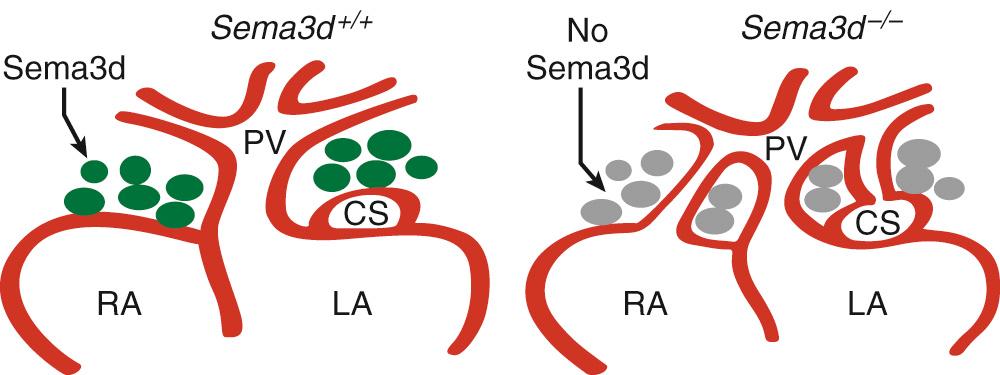
Anomalous pulmonary venous drainage can result from failure of fusion between the left atrial outpouching and the pulmonary venous plexus, or from malposition of the relationship between the atrial outpouching and the development of the atrial septum. If all the pulmonary veins maintain an anomalous connection to a single systemic venous site, the lesion is termed total anomalous pulmonary venous drainage . If all the pulmonary veins drain anomalously to multiple discrete systemic veins, the lesion is called mixed total anomalous pulmonary venous drainage . If one to three pulmonary veins drain via an anomalous pathway and at least one pulmonary vein drains to the left atrium, the lesion is termed partial anomalous pulmonary venous drainage .
Partial anomalous pulmonary venous drainage is characterized by a failure of one to three of the pulmonary veins to connect with the left atrium during fetal development. Typically, the pulmonary vein has an abnormal connection to the superior vena cava near the cavoatrial junction. More than 80% of patients have associated congenital heart defects, the most common of which is an atrial septal defect. A minority of patients (18%) have an intact atrial septum. Most commonly, a combination of right upper and middle lobe pulmonary veins drain to the superior vena caval–right atrial junction ( Fig. 115-4 ). Less commonly, isolated anomalous right upper lobe venous drainage is present. Least commonly, the entire right lung drains via an anomalous vein into the right atrium. Other less common sites of anomalous venous drainage include the inferior vena cava (e.g., as part of the scimitar syndrome), the left-sided superior vena cava, and the innominate vein. The left pulmonary veins rarely can also have an anomalous drainage to the systemic venous circulation as isolated disease.
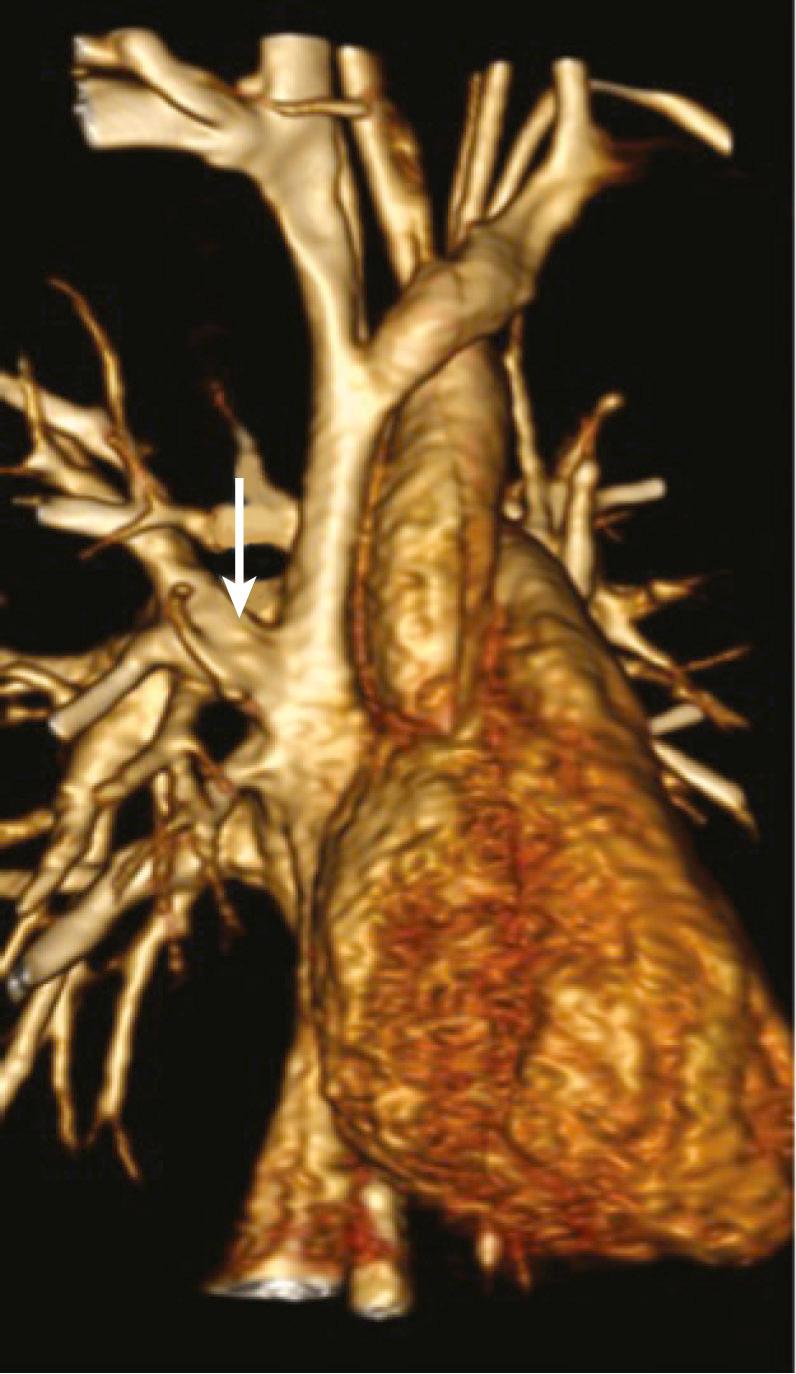
Patients are often asymptomatic and display a murmur noted on routine examination that is caused by increased flow across the pulmonary valve. A split and prominent second heart sound is also present. Symptomatic patients display the sequelae of a left-to-right shunt, including decreased exercise tolerance and poor growth. Patients are not cyanotic unless they have developed pulmonary hypertension as a late manifestation of a large left-to-right shunt. In such patients, Eisenmenger syndrome is characterized by the reversal of the shunt from right to left in association with an atrial septal defect.
The dominant hemodynamic abnormality is related to the left-to-right shunt imposed by pulmonary venous drainage into the right atrium. In the absence of an atrial septal defect, the left-to-right shunt is limited by the amount of flow in the anomalous pulmonary vein. In contrast, an associated atrial septal defect adds potential for increased left-to-right shunting at the atrial level. Increased right-sided flow can lead to right ventricular dilation, tricuspid insufficiency, and supraventricular arrhythmias.
The goal of surgical therapy is to divert the anomalous pulmonary venous effluent to the left atrium in an unobstructed fashion. In the presence of a sinus venosus atrial septal defect and anomalous right upper pulmonary veins, the flow is diverted with a baffle constructed along the edge of the sinus venosus atrial septal defect. The defect may have to be enlarged to create an unobstructed pathway to the left atrium. In the absence of an atrial septal defect (i.e., the atrial septum is intact), an atrial septal defect must be created in the region of the fossa ovalis with extension in the region of the limbus and a similar baffle constructed to divert flow from the anomalous pulmonary vein to the newly created atrial septal defect.
Careful review of the anatomy by preoperative echocardiography, computed tomography, or magnetic resonance imaging is the single most important component in developing an operative plan. Definition of the pulmonary venous anatomy and associated defects allows assessment of options for cannulation techniques and surgical approaches. This is especially important in preparation for partial anomalous pulmonary venous drainage, because the location of the anomalous pulmonary venous drainage determines the feasibility of a minimally invasive approach and placement of venous cannulas. A common clinical scenario involves an anomalous right upper pulmonary vein inserting high into the superior vena cava, at or above the level of the pulmonary artery. Options for control of the superior vena cava include a high cannulation of the superior vena cava, cannulation of the innominate vein, or percutaneous cannulation via the internal jugular vein with vacuum-assisted venous drainage. A minimally invasive approach through a lower midline partial sternal split can be difficult when a high insertion of an anomalous pulmonary vein is present. In this case a right posterior lateral minithoracotomy can be used as a minimally invasive approach to achieve better access to the high pulmonary veins. The cannulation strategy for this approach includes percutaneous cannulation of the internal jugular vein and direct surgical cannulation of the right femoral vein and artery. The use of peripheral cannulation augmented with vacuum assisted venous drainage is helpful. Limitations to the use of this approach are: patient's weight less than 20 kg and femoral vein or artery anomalies. During cardiopulmonary bypass, monitoring of right leg near-infrared spectroscopy is suggested. Near-infrared spectroscopy saturations less than 30% suggest that distal leg perfusion is insufficient. In patients with small femoral arteries, the use of a graft sewn to the femoral artery in end-to-side fashion can be helpful to avoid problems with distal leg perfusion.
A final technique to consider is the use of a straight venous cannula in the right atrial appendage, which can be directed into the superior vena cava. After snaring the cava around the cannula (cephalad to the anomalous pulmonary vein insertion), an atrial incision allows access to the origin of the anomalous pulmonary vein from within the atrium. Although this technique is easily accomplished with a minimally invasive lower midline partial sternal split, working around the cannula through the right atrial–superior vena caval junction can be challenging.
Before initiation of cardiopulmonary bypass (CPB), the location of the pulmonary veins is confirmed. Drainage to the superior vena cava requires dissection of the lateral margin of the superior vena cava to identify all pulmonary vein branches. During dissection of the superior vena cava and right pulmonary veins particular attention is needed to avoid injury to the right phrenic nerve. Frequently, multiple branches drain into the vena cava through a large confluence. The source of the veins is not always clear, and any systemic veins draining into the region must be identified. When the source of the pulmonary venous drainage is not clearly defined, needle aspiration can be used to determine the oxygen saturation of the effluent, and then the systemic veins can be distinguished from the pulmonary veins.
After heparinization, cannulation, and initiation of normothermic CPB, the aorta is clamped and blood cardioplegic arrest is obtained. It is often helpful to place a vent into the left atrium for later de-airing. A lateral right atriotomy is made and the atrium is explored to identify any additional anomalies ( Fig. 115-5 ). If the atrial septum is intact, an atrial septal defect is created by incising the region of the foramen ovale and extending the incision across the limbus in the direction of the anomalous pulmonary vein. Resection in the region of the limbus allows enlargement of the newly created atrial septal defect. Injury to the sinus node artery can occur when creating the atrial septal defect in patients whose artery courses through the superior portion of the intra-atrial septum. Enlargement of the sinus venosus defect might be necessary if it is too small to divert the anomalous pulmonary veins to the left atrium. Typically, a glutaraldehyde-treated pericardial patch can be used to create a baffle, so that pulmonary venous blood flows beneath the baffle and through the atrial septal defect into the left atrium.
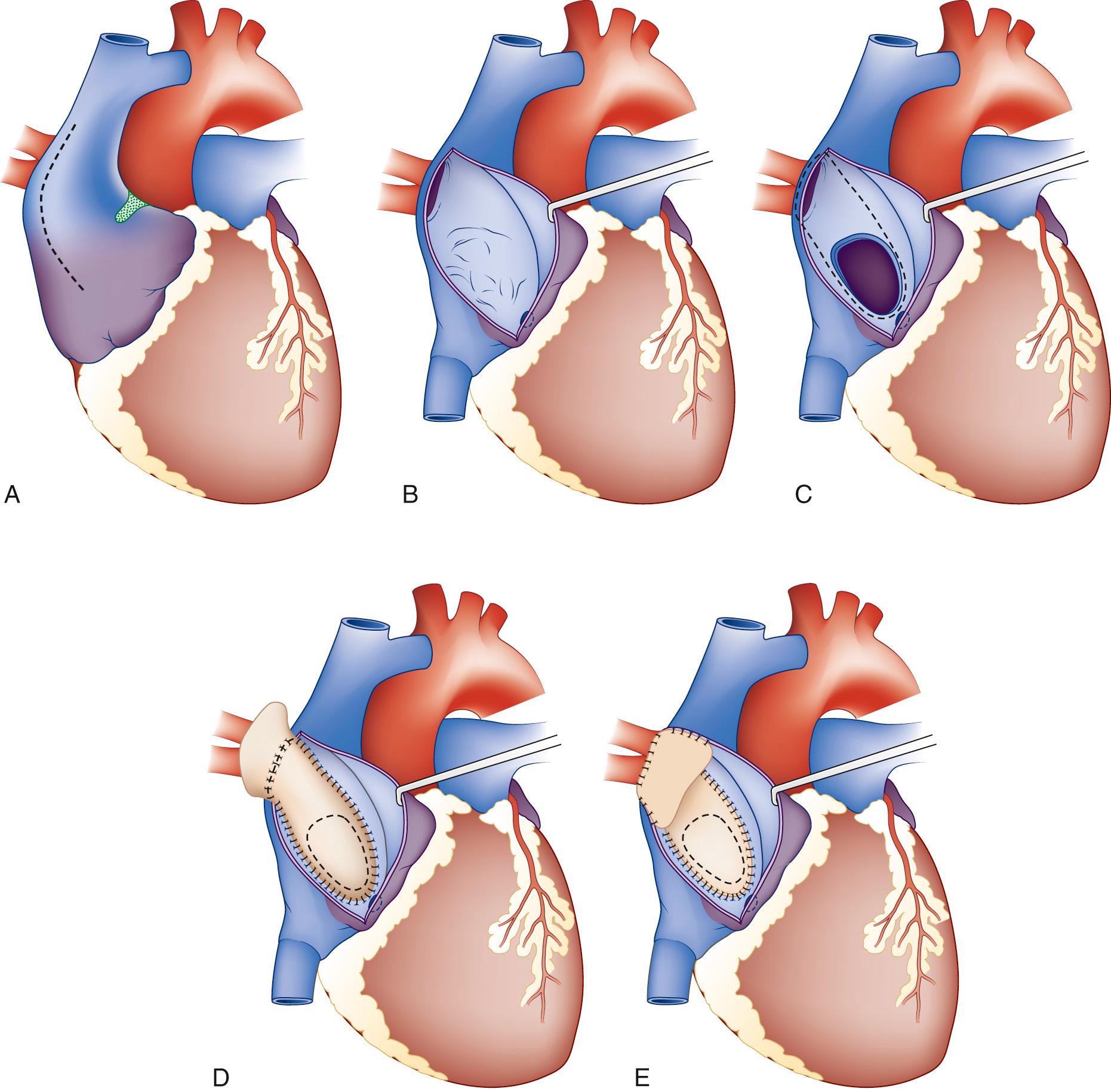
Systemic venous blood from the superior vena cava must pass to the right atrium over the pulmonary vein–to–left atrial baffle without obstruction. If the origin of the pulmonary vein was high in the superior vena cava, the baffle must be constructed carefully to avoid obstruction to flow on either side of the baffle. A longitudinal incision in the lateral aspect of the superior vena cava allows the baffle construction to be better visualized. Placement of the incision on the lateral aspect of the superior vena cava is important to diminish the risk of injury to the sinus node. Closure of the superior vena cava incision with a generous patch to augment the superior vena cava diameter can be used to prevent stenosis of the superior cavoatrial junction.
Alternatively, a new anastomosis between the superior vena cava and the right atrial appendage is established by dividing the superior vena cava cephalad to the anomalous pulmonary venous entry and translocating the cephalad end of the superior vena cava to the right atrial appendage (Warden technique). The divided cardiac end of the superior vena cava (bearing the anomalous pulmonary venous connection) is closed, and a baffle is created from the orifice of the superior vena cava to the newly created atrial septal defect. By creating a new superior vena caval–right atrial junction, this procedure eliminates the need to partition the superior vena cava with a baffle dividing the systemic and pulmonary venous flow paths. This approach can be particularly helpful in infants and small children with a high insertion of an anomalous pulmonary vein into the superior vena cava.
Early and long-term outcomes for patients after repair are excellent. In children, closure of an associated atrial septal defect almost eliminates the risk of late development of atrial arrhythmias. However, in adults, closure of the atrial septal defect is associated with persistent risk of development of atrial arrhythmias. Although extrapolation of these data for atrial septal defect closure to patients with partial anomalous pulmonary venous drainage and intact atrial septum has not been specifically validated, it seems reasonable to conclude that early removal of a left-to-right shunt associated with right ventricular overload is appropriate. In fact, surgical closure of the sinus venosus atrial septal defect at an older age is associated with increased risk of mortality, adverse events, and poor functional outcomes.
Pertinent complications after repair of partial anomalous pulmonary venous drainage include stenosis of the superior vena cava or the anomalous pulmonary vein, residual atrial septal defects, and atrial arrhythmias or sinus node dysfunction (or both). Failure to include all pulmonary veins in the newly constructed baffle to the left atrium can result in a residual left-to-right shunt. However, incorporation of a systemic vein into the newly constructed baffle results in a residual right-to-left shunt. Finally, injury to the sinus node or sinus node artery can lead to the requirement for pacemaker insertion in patients with severe sinus node dysfunction.
Scimitar syndrome is an unusual congenital anomaly that is manifested by partial anomalous pulmonary venous drainage of the right lung to the inferior vena cava; it is often associated with hypoplasia of the right lung, dextrocardia, systemic pulmonary arterial supply from the abdominal aorta to the lower lobe of the right lung, and bronchial abnormalities. Other commonly associated anomalies include atrial septal defect, aortic coarctation, and a left-sided superior vena cava. The morphology of the anomalous pulmonary venous drainage to the right lower lobe creates a characteristic appearance to the right-sided heart border suggestive of a Turkish sword, hence the term scimitar syndrome ( Fig. 115-6 ). The right-sided pulmonary veins drain to the inferior portions of the right atrium, the inferior vena caval–right atrial junction, or, more commonly, the inferior vena cava below the diaphragm. Stenosis can occur in 10% to 20% of scimitar veins at their junction to the inferior vena cava.
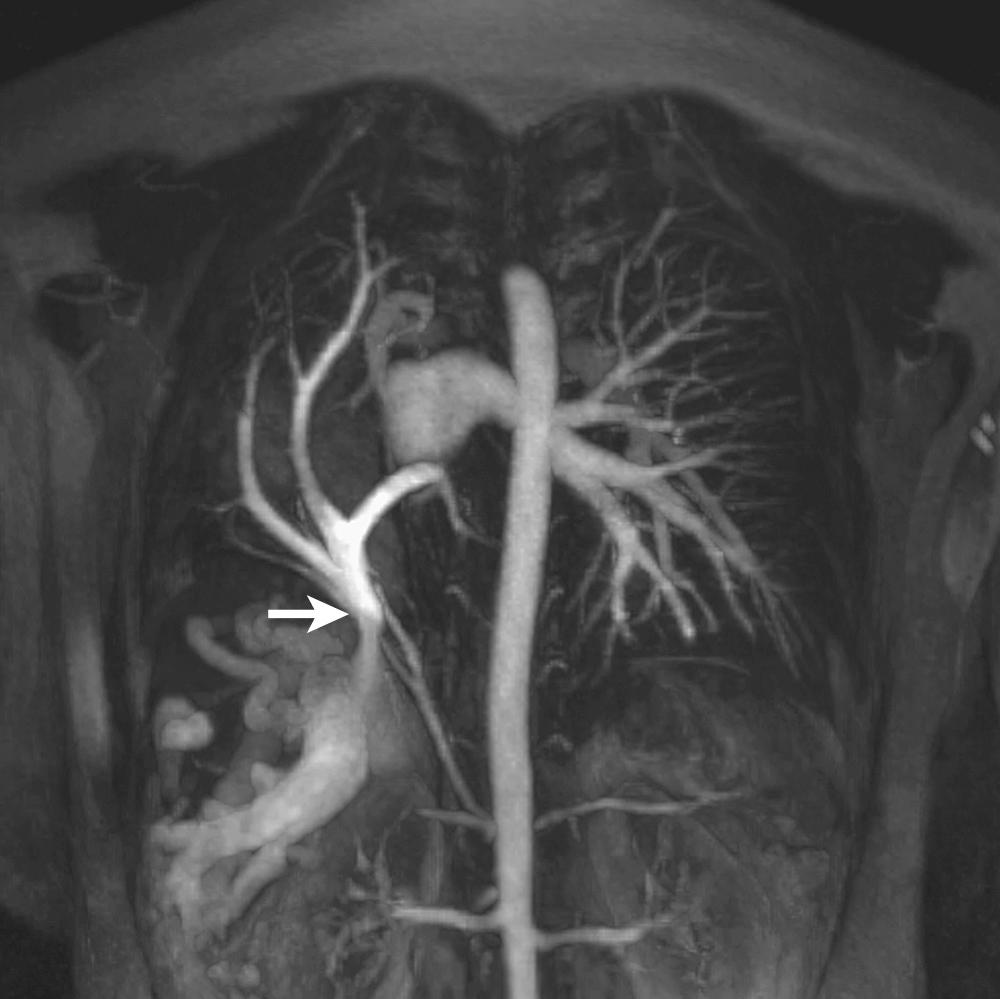
The presentation of patients with scimitar syndrome can be variable and depends on the severity of the associated lesions. There are generally two forms of clinical presentation in scimitar syndrome: (1) an infantile form with significant symptoms, morbidity, and mortality and (2) a form with mild symptoms seen in children or adults. At the most benign end of the spectrum, patients can display an asymptomatic flow murmur on physical examination as a result of increased pulmonary blood flow secondary to the left-to-right shunt caused by the anomalous pulmonary venous drainage to the inferior vena cava. At the most severe end of the spectrum, infants can exhibit symptoms of severe congestive heart failure, failure to thrive, tachypnea, and occasionally cyanosis. Infantile pulmonary artery pressures are often elevated (e.g., >40% of the systemic pressure), with a ratio of pulmonary blood flow (Qp) to systemic blood flow (Qs), or Qp/Qs, of up to 2:1.
The management strategy for patients with scimitar syndrome is determined by the degree of right lung hypoplasia, the presence of aortopulmonary sources of blood flow to the right lung, and the location and pattern of the right-sided pulmonary venous drainage. The degree of right lung hypoplasia is an important determinant of the likelihood of salvaging a functional right lung, and in cases of severe hypoplasia, a right pneumonectomy has been advocated. In cases with less severe hypoplasia, attention is turned to correction of the pulmonary venous drainage patterns, control of aortopulmonary sources of blood flow, and correction of associated anomalies. Control of the aortopulmonary sources of blood flow can be achieved with coil embolization in the catheterization laboratory or with ligation in the operating room.
Surgical repair of the pulmonary venous drainage is designed to create unobstructed flow from the anomalous pulmonary vein to the left atrium. To accomplish this repair, a direct surgical approach is to place a long baffle in the lumen of the inferior vena cava to channel the anomalous pulmonary vein effluent to the right atrium, and then through an atrial septal defect to the left atrium (originally described by Zubiate and Kay in 1962). It can be challenging to create an unobstructed baffle when the anomalous pulmonary venous connection is relatively caudad in the inferior vena cava. To construct a partitioning baffle, a period of circulatory arrest is typically necessary to secure a baffle between the pulmonary vein orifice and left atrium that allows unobstructed pulmonary vein flow without restricting flow in the inferior vena cava or in nearby hepatic veins.
When partitioning the inferior vena cava between the systemic and pulmonary venous flow paths, a right atrial incision can be carried down to the level of the anomalous pulmonary vein orifice, and the orifice is augmented with a patch of autologous pericardium if stenosis is present. The baffle is then constructed in the lumen of the inferior vena cava, and, if necessary, the inferior vena cava diameter can be augmented with a patch to ensure that there is no residual obstruction in the vena cava. This technique has a relatively high incidence of late stenosis, presumably because of the length of the intracaval baffle and because the blood must pass through a nearly 180-degree turn as it travels caudad toward the inferior vena cava and then cephalad up through the baffle to the atrial septal defect.
A second approach is to divide the anomalous pulmonary vein and reimplant it at a convenient location in the right atrium and then create a baffle to divert flow to the left atrium through an atrial septal incision or atrial septal defect if present. This approach provides a shorter, more direct pathway for the pulmonary venous effluent. It is difficult to use this approach, however, when the anomalous pulmonary vein courses in the posterior portion of the lung and necessitates a great deal of augmentation to create an anastomosis with the atrium. When the pulmonary vein passes through the posterior mediastinum and the right lung is relatively hypoplastic, Huddleston and associates recommend pneumonectomy because of the high incidence of late stenosis with reimplantation techniques. As further justification of pneumonectomy in this setting, Huddleston and colleagues point out that the left lung has typically undergone some compensatory growth. Furthermore, perfusion scans typically demonstrate diminished pulmonary blood flow to the right lung in patients with scimitar syndrome. Calhoun and Mee described an alternative surgical approach for this entity, in which the inferior vena cava is transected under deep hypothermic circulatory arrest and divided into posterior (the anomalous pulmonary vein channel) and anterior (inferior vena cava and hepatic vein) compartments with a pericardial patch. An incision is made on the inferior aspect of the left atrium and carried to the atrial septum. The posterior compartment of the inferior vena cava is sutured to the left atriotomy, and the pericardial patch is used to close the atrial septal defect. The anterior compartment of the inferior vena cava is anastomosed to the right atrium. This approach connects the anomalous pulmonary vein to the left atrium at a relatively gentle angle. Brown and coworkers reported favorable results with direct anastomosis of the anomalous pulmonary vein to the left atrium via right thoracotomy without the use of CPB.
Become a Clinical Tree membership for Full access and enjoy Unlimited articles
If you are a member. Log in here